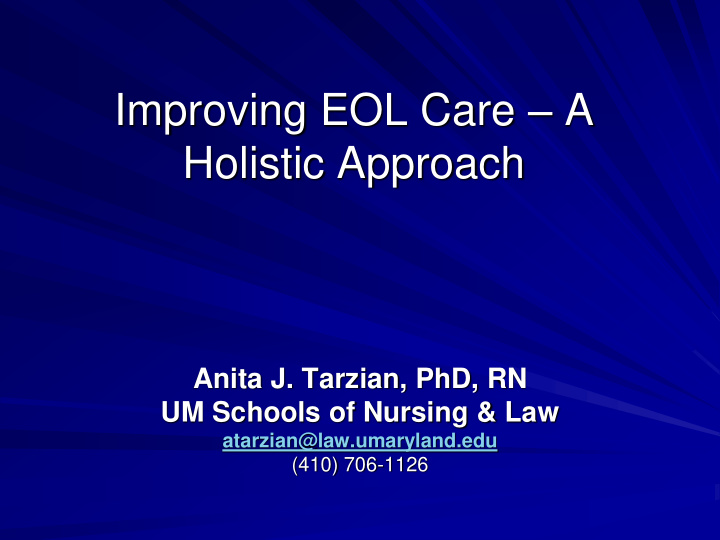



Improving EOL Care – A Holistic Approach Anita J. Tarzian, PhD, RN UM Schools of Nursing & Law atarzian@law.umaryland.edu (410) 706-1126
VALUES IN CONFLICT Prolonging life Palliating suffering Minimizing future regrets Stewardship of limited resources
TIMING OF B.R.’s DEATH DIED “AT HER DIED DYING PREMATURELY PROLONGED RIGHT TIME”
Mortality awareness part of human experience
“It doesn’t matter how long your therapy session is, you always have your breakthrough 10 minutes before the end .”
Embracing death to embrace life http://considertheconversation.com/ http://deathoverdinner.org/ http://deathcafe.com/ http://celebrationsoflife.net/ethicalwills/ http://GetPalliativeCare.com https://www.hospicenet.org/
http://www.ted.com/talks/candy_chang_before_i_die_i_wan t_to?language=en
What IS “Comfort Care”? Prevent/manage symptoms Offer information about dying process Elicit religious/spiritual traditions Identify those who need to say goodbye Decide where last days should be spent Arnold, B. (2011). What to do after the patient is made comfort measures only. Institute to Enhance Palliative Care, University of Pittsburgh Medical Center, 11(2).
Tasks of Dying (& Living!) Byock (2004) The Four Things that Matter Most Ask for forgiveness Offer: – forgiveness (to others & self) – heartfelt thanks – sentiments of love Say goodbye
“There’s nothing we can do.” The toll a mishandled death takes on survivors in terms of negative mental health consequences, lost productivity, diminished human flourishing, is as real a health issue as any other. Preventing these outcomes is NOT “doing nothing”!
NURTURING THE CAREGIVERS Jeffrey Rothenberg, M.D. IU School of Medicine 3 breathing exercises by Andrew Weil: http://www.drweil.com/drw/u/ART00521/three-breathing-exercises.html
DIFFICULT CONVERSATIONS http://depts.washington.edu/oncotalk/ Meier, D. (May 19, 2014). Teaching doctors when to stop treatment. (excerpted from journal Health Affairs). Available at: http://www.washingtonpost.com/national/health-science/teaching- doctors-when-to-stop-treatment/2014/05/19/e643d190-caf5-11e3-93eb-6c0037dde2ad_story.html
UNECESSARY CONFUSION & DISTRESS PROBLEM REMEDY Consensus on standard Evidence-based practice, of care unrecognized team huddles http://www.choosingwisely.org/ IPE training/education at all Variability in practice & levels; organizational buy- changing staff in Identify & support lead Fragmented care, no clinician; ethics consult captain mixed messages
MOVING THE LINE
“RITUAL CPR” B.R.’s husband’s Staff’s perspective perspective “She would want to “Attempting CPR won’t live.” achieve its goal.” “I have to know I Breaking ribs and did everything shocking her heart is possible.” not respectful or dignified. “You are not alone.” “I can’t live without her.”
What Every Patient Deserves… Symptoms managed Family supported Religious/spiritual traditions honored Goodbyes facilitated (esp. with children!) Choice of where to die offered Arnold, B. (2011). What to do after the patient is made comfort measures only. Institute to Enhance Palliative Care, University of Pittsburgh Medical Center, 11(2).
MORE ONLINE RESOURCES Maryland MOLST – http://marylandmolst.org/ Massachusetts MOLST video – http://molst-ma.org/molst-stories Respecting Your Choices – http://www.gundersenhealth.org/respecting- choices Chronic Disorders of Consciousness & Patients’ experiences on film – http://cdoc.org.uk & http://www.healthtalk.org/
Sit, be still, and listen, because you're drunk and we're at the edge of the roof. - Rumi
Staying Present
Embracing Palliative Care
TIMING & TRUST “It is essential to ensure that some level of trust and rapport has been established with the family before conversation begins about POLST, while also assessing cultural considerations and the context of familial hope … pushing this discussion … is not effective or helpful in assuring best patient care .” - Maureen Horgan, program coordinator for Stepping Stones Pediatric Palliative Care and Hospice Program in Seattle, WA http://med.fsu.edu/userFiles/file/POLST%20in%20Pedi atrics.pdf
Informed consent Understand relevant information Appreciate choices & consequences Reason about options
Difference between “being disabled” and “dying” “… a progressive decline despite appropriate intervention and treatment gives a clear message: the individual is dying, not because of a disability, but because the body is failing.” - Sheehan, M. (2003). Theoretical Medicine, 24, 525-533 Easier said than done with modern technology!
Continued life may not be in best interest when … Treatment ineffective; only prolongs dying Irreversible coma or permanent vegetative state Treatment itself would impose excessive pain and suffering Principles: Dignity, Respect for Autonomy, Life, Equality - American Association on Intellectual and Developmental Disabilities - Position Statement on Caring at the End of Life (2012) http://aaidd.org/news-policy/policy/position-statements/caring-at-the- end-of-life#.UxN9h4Wtyi0
WHO IS TARGET OF CARE? ELLIE FAMIILY NOW FAMILY FUTURE
ONLINE RESOURCES Perinatal Hospice – http://perinatalhospice.org/ Pediatric Hospice (NHPCO) – http://www.nhpco.org/pediatric Child & Teen Grief (Victoria Hospice) http://www.victoriahospice.org/sites/default/files/imce/ VicHospChildrenTeenGrief.pdf Devaluing People with Disabilities (NDRN) – http://www.ndrn.org/media/publications/483- devaluing-people-with-disabilities.html
Recommend
More recommend